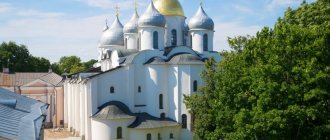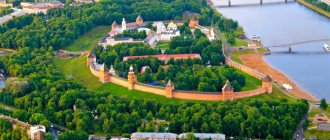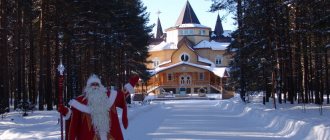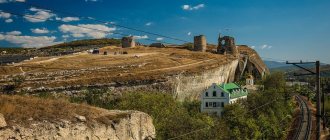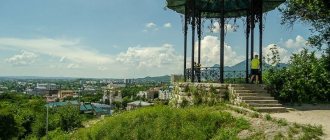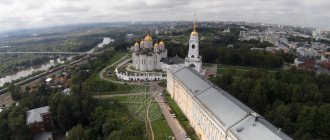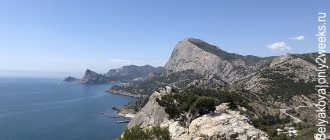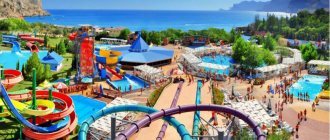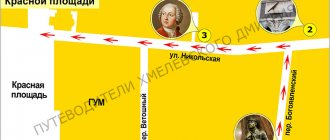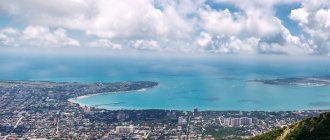I propose to travel back in time to Veliky Novgorod - one of the first capitals of the ancient Russian state. Learn the legends about Rurik and Sadko. See the sights of Veliky Novgorod, imagine yourself as a participant in the Novgorod veche on the square near the St. Sophia Cathedral. View Novgorod Detinets. This is the first red brick Kremlin in Russia. Try purely Novgorod, old Russian food. I’ll tell you when it’s best to go to immerse yourself in the atmosphere of historical events and what souvenirs you should pay attention to.
A few facts from the history of Veliky Novgorod
Panorama of Veliky Novgorod.
Volkhov River Veliky Novgorod is a city with more than 1000 years of history. This is the only city that is majestically called “lord” and “sovereign”.
- The date of the first mention in the chronicle is 859. The tribes living in these parts called upon three Varangian brothers to reign, the eldest of whom was Rurik. He founded a settlement, the remains of which can still be seen today - more about this in the section “What to see in the vicinity of Novgorod”.
- The Novgorod squad helped the prophetic Oleg to conquer Kyiv in 882 and form a single state of Kievan Rus.
- The baptist of Rus', Prince Vladimir, and his son Yaroslav the Wise ruled here at different times. The latter granted the city independence. Since 1136, Mr. Veliky Novgorod became “free to princes” and turned into a republic governed by the veche.
- In 1478, Novgorod and all its lands submitted to Ivan III and became part of Muscovite Rus'. To consolidate the result and finally eradicate the “liberty of Novgorod,” about 7,000 boyars and merchants were expelled from the city, and the “best people” of the Moscow lands were settled in their place.
This is the past for which they go to Novgorod.
The historical prefix “Great” was officially returned to Novgorod only in 1999.
Independent walk through the Kremlin at night
I really liked the night illumination of the Kremlin and the fact that it is open until late. Of course, this is actually not a tourist site, but the only illuminated passage to the bridge over the river. In the evenings there are almost no people there and there are no large groups at all, so you can calmly walk in silence and enjoy not the tourist city, but the grandeur of the ancient Kremlin, its beautiful and beautiful view.
It’s a pity that the shopping side (where there are many churches and a wall with arches) is not illuminated at all. Therefore, it will take you a maximum of 40 minutes to walk around and inside the Kremlin.
Opening hours of the Novgorod Kremlin: from 6.00 to 24.00, admission is free and it is very pleasant to walk around it
There are several interesting subjects on the monument, so I recommend a separate article on this monument to the Millennium of Russia
Novgorod Kremlin: main objects, museum exhibits
View of the bridge and one of the walls of the Kremlin.
Relics are everywhere in Novgorod.
11 historical monuments of Novgorod and the surrounding area constitute a UNESCO architectural heritage. This is the preserved architecture of the pre-Mongol period.
I recommend starting your walk from Detinets, also known as the Novgorod Kremlin. In 2022, it was included in the list of the most beautiful castles in the world according to CNN International.
The Kremlin was founded in 1044 by the son of Yaroslav the Wise, Vladimir, and acquired its modern appearance in the 15th century under Ivan III. Detinets - from the combination “children of God”. This is what the warriors who lived here were called.
Monument "Millennium of Russia"
How to build a route
Enter from the city side through the Resurrection Arch (there was once a tower here). In the center of the Kremlin you will see the monument “Millennium of Russia” of 1862. It resembles both Monomakh’s hat and the veche bell.
On the majestic monument there are 128 significant persons for the history of the country.
You won’t find Ivan the Terrible there - he is persona non grata in Novgorod for the pogrom he committed in 1570.
Novgorodians were thrown into the river, “fried” in hot flour, and beaten to death with sticks. This was punishment for suspicion of conspiracy.
St. Sophia Cathedral in Novgorod
St. Sophia Cathedral is the oldest existing ancient Russian temple in Russia (1050). It was built by masters from Kyiv and Byzantium.
- The crowns of the chapters are like ancient helmets. On the central dome there is a gilded dove (to prevent real ones from landing on it, it is “decorated” with needles).
- Take a look inside the cathedral, where the oldest frescoes have been preserved: biblical prophets and angels, Saints Constantine and Helen.
- Alexander Nevsky prayed here. A meeting was convened on the square in front of the cathedral.
On the western side of the temple there is the Magdeburg Gate of 1153. The bronze relic is literally strewn with relief images of Gospel scenes. According to one version, this is a war trophy - the gate was recaptured from the Swedes.
Interior of the Vladychna Chamber / photo S. Makhlov
Behind the St. Sophia Cathedral you will see the Vladychnaya (Faceted) Chamber. This is one of the oldest civil buildings in Rus' (1433), an example of brick Gothic. There is an exhibition of jewelry art here: ancient jewelry, religious objects and other treasures of Novgorod cathedrals. Admission is paid, closed on Monday.
Nearby stands the 40-meter-high Clock Bell from 1673 - a snow-white watchtower with clocks on 4 cardinal directions. This is the tallest building in the Kremlin.
Returning to the center of the Kremlin, take a look at the Public Places Building , the main building of the museum. Admission is paid, closed on Tuesday.
Be sure to check out:
- World masterpieces of icon painting (for example, “Apostles Peter and Paul” of the 11th century),
- Fragments of wooden pavements, which were built earlier than the pavements of Paris and London,
- Psalter of the 11th century. - the most ancient Slavic book. It was found at the Trinity excavation site in Veliky Novgorod.
Novgorod Bells
Climb and walk along the Battle Course , where archers served on the walls and towers. Tickets are sold in the Belfry of St. Sophia Cathedral. The arched belfry is an architectural monument, plus ancient bells are collected here, the largest of which weighs 320 kg.
Through the Prechistenskaya Arch you will come out onto a pedestrian bridge near the Kremlin, it is called Gorbaty.
2 years ago, at the bottom of the Volkhov River, archaeologists discovered the supports of the oldest bridge in Rus'. The examination dated the buildings to the 10th century.
You can also swim under the Kremlin walls. There is a beach here - real, with golden sand.
The same beach near the walls of the Novgorod Kremlin / photo by A. Patrikeev
How to get to the Kremlin
From the railway or bus station, 20 minutes along Voskresensky Boulevard to Sofiyskaya Square. Entrance to the Kremlin territory is free. Walking is allowed from 6 am to midnight.
Cities and villages
Velikiy Novgorod
In the legends of the Scandinavians, Novgorod is found under the name Holmgard, which means “a city that goes under water during floods.” It’s not surprising, because there are many bodies of water around. One river divides the city into 2 parts. Previously, these halves fought with each other.
According to legend, Perun is involved in the feud, whose statue the merchants threw into the Volkhov. He swam to the bridge and threw a stick at it with the words: “Here is a souvenir from me, Novgorodians.” After this, regular massacres took place on the bridge.
- Rurik settlement. It is believed that the city was originally located here. But, according to archaeological excavations, it became impossible to continue development, so a new fortress was founded. It was this event that determined the name of the settlement: the new city - Novgorod.
- Novgorod Detinets is one of the oldest surviving kremlins in our country. It was the first in Rus' to be built of red brick. It was here that the trend for battlements began.
- Saint Sophia Cathedral. The western gate of the temple comes from Sweden. In the 12th century they were brought as a trophy, which turned out to be so valuable that 500 years later the Swedes tried to return it. From the Great Patriotic War until 2002, the cross of the cathedral was in Spain, where it was taken after one of the bombings. According to legend, the bird on it is a dove, petrified from the horrors that took place in the city during the massacre of Ivan the Terrible. The cathedral houses the miraculous icon of the Mother of God “The Sign”, which once saved the city from invaders.
A detailed guide to Veliky Novgorod: why go here and what to see.
Valdai
The city is named after the lake on the shore of which it is located. In the very center of Valdai, a map with all the attractions is drawn on the wall of a residential building. Another way to get around the city is the metro. True, it is virtual. But, despite this, tourists will be willing to sell a diagram with stations-attractions and even a real token.
- Bell Museum. During the time of Ivan the Terrible, it was decided to transport the bell from St. Sophia Cathedral to Moscow. But on the Valdai Mountains the sleigh skidded and overturned. The bell fell and crumbled into many small bells. Local residents collected them and made copies. It is believed that the Valdai bell brings happiness to the home.
- The museum of the county town is a family album of Valdai. Here the story is told through the fates of local residents, household items, habits, legends and photographs.
- The holy spring "Tekunok" is located near the city. Its water has healing powers: it cures eye diseases.
How to get to Valdai, what is important to know when coming here and what to do here.
Staraya Russa
According to legend, the city was founded by the knight Rus, who wandered around the country until he found this place. Scientists date the appearance of Staraya Russa to the end of the 10th century, but locals believe that it existed 2.5 thousand years BC. e.
Not far from the city there is an unusual forest in which there is no echo. According to legend, a lonely landowner lived in it, in whose garden there were watermelons, bamboo, melons and other exotic plants.
- House-Museum of F. M. Dostoevsky. The writer’s biographers note that Staraya Russa was the only place he chose to live himself. “Demons”, “The Brothers Karamazov”, an article for “A Writer’s Diary” and “Teenager” were written here.
- The monument to the infantrymen of the Wilmanstrand Regiment is dedicated to the participants of the Russian-Japanese War. Its construction was sponsored by Nicholas II, who personally escorted the soldiers to the battlefield. On top of the five-meter-high obelisk sits an eagle with outstretched wings, one of which was pierced by bullets during the Great Patriotic War.
- The Staraya Russa resort was visited by N. Dobrolyubov, K. Stanislavsky and M. Gorky. The first theater in the province was formed here, where V.F. Komissarzhevskaya began her career. At the end of the 19th century, it was the place of work of the first Russian woman to become a doctor of medical sciences - V. A. Kashevarova-Rudneva.
What else is worth knowing about Staraya Russa for those who are going here?
Yaroslav's yard and bargaining - back to merchant Rus'
Church of Paraskeva Pyatnitsa on Torg / photo by S. Makhlov
Prince Yaroslav lived on the trading side - this is described in the chronicle.
Afterwards, merchants occupied the land, expanding trade here. Overseas ships approached the pier. In the 16th century, about 2,000 shops and barns were located on a small plot of land at Torg.
In the 18th century, Gostiny Dvor was built on this site. The Gate Tower (XVII century) and the Arcade (XVIII century) are the only things left from it.
Behind the Arcade, 7 temples were “clustered together”, which were erected by princes and merchants.
The churches at Torgu are a miracle of northern temple architecture. Worth a look:
- St. Nicholas Cathedral of 1136 is the oldest. Fragments of original painting from the 12th century have been preserved in the interior.
- The Church of Paraskeva Pyatnitsa is a cross-domed, three-nave, four-pillar building built in 1207. Novgorod merchants considered Saint Paraskeva their patroness. Now they are praying for her female destiny - they go around her 3 times, counting the corners.
- The Church of the Myrrh-Bearing Women, 1510, is austere, almost without decoration, made of bricks of different sizes. Take a look at the under-church and immerse yourself in the past - there are exhibitions about carpentry, leatherwork, shoemaking, and fishing, interactive excursions and master classes are held here.
How to get there
Right bank of the Volkhov River, address: st. Bolshaya Moskovskaya, 1.
Use an audio guide for a walk along the Trade Side.
Natural beauty
The picturesque surroundings attract attention at any time. The delicate lace of frost on the trees imperceptibly changes with young sticky leaves, walks bring an unforgettable experience.
Volkhov River and Lake Ilmen
Epics and legends about the land of Novgorod necessarily mention these names. The source of the river is a lake stretching for 45 km. The city stands on both sides of a river bed that stretches for 224 km through several regions, the banks are connected by bridges.
Lake Ilmen is large and full-flowing, more like a sea; the volume of water ensures the flow of 50 large and small rivers.
Motor ship excursions along the Volkhov to Lake Ilmen
In the warm season, cruises from St. Petersburg are very popular; the route runs through Ladoga and ends at the city walls. Departures are daily, travel time is 1.5 - 2 hours, there are discounts on children's tickets.
Hanseatic fountain - water “negotiation table”
Fountain with flags of the countries of the Hanseatic League / photo by S. Makhlov
Hansa is a powerful trade union of 130 cities that arose in the 13th century. Of the Russian cities, only Novgorod and Pskov were included in it.
In the 80s of the 20th century, the Union was recreated, and in 2009 a special sign and fountain were installed in Veliky Novgorod.
The black granite fountain is stylized as a negotiation table. It depicts the coats of arms of 16 countries of the Hanseatic League in modern times. On sunny days, the images seem to glow from under the water. Countries are not signed, test your knowledge of coats of arms.
How to get there
You will find the fountain on the territory of Yaroslav's courtyard.
Children's game studio "Vykrutasy"
Here you will find entertainment for every taste. Why is this studio so popular among residents of Veliky Novgorod? Firstly, animators work here every day and change their costumes every day. For example, if yesterday you had fun with Mickey Mouse, then tomorrow a daring and brave pirate may be waiting for you. They will sing songs, dance and dance in circles, ask riddles and organize competitions.
Secondly, the studio is famous for its variety of entertainment. There is a special children's room where kids can play in a dry pool filled with plastic balls, draw in coloring books, and play board games. There is also a section with slot machines and cars with a steering wheel connected to the display. Let your child feel like a real racer.
The main feature of this place is the cooking lessons. Children will be taught how to cook their favorite desserts. There is no need to bring any products, everything has already been purchased.
The Victory Monument is the only equestrian statue in Novgorod
Victory Monument / photo S. Makhlov
The monument was erected in the year of the 30th anniversary of the liberation of Novgorod from the Nazis.
An interesting detail is that under the horse’s belly there is a mangled swastika. Behind the statue is a 23.5 m high brick tower. It is not possible to climb to the observation deck - the entrance is closed due to emergency conditions.
At the foot there is a small exhibition of military equipment: a T-70 light tank and 76 mm guns.
How to get there
The monument is located in the southern part of the Kremlin Park on Catherine Hill. It can be seen from the Settlement and from the bridge.
Folk rock musical "Sadko"
Recently, someone from the staff of this musical wrote to me. I wrote with all the grace of Russian business - without introducing myself. Therefore, I don’t even know who it was, but they said that an open-air theater had appeared. I contacted a director I knew in Novgorod and asked for his recommendation, he said that the show was worthy and you could go see it. They have a regular schedule, and I really like the idea itself - a modern show in old scenery.
The schedule and tickets can be viewed here: https://sadko.pro/ru-page.html
Museum of Artistic Culture of Novgorod - interactively about the important
The museum's holdings include more than 6,500 exhibits.
It will be interesting here:
- be transported to a porcelain factory - the interior of the workshop in the form of a forge, baked brick, a feeling of heat, the shine of “Kuznetsov porcelain” with a cobalt coating,
- learn the history of 25 Novgorod monasteries,
- play numerous art games and quest games.
How to get there
The museum is located in the sister building of the Desyatinny Monastery (Desiatinny Monastery, 3). Closed on Monday.
Monasteries and temples of the Novgorod land
Novgorod monasteries and churches - ancient architecture of the 11th-14th centuries.
Worth seeing:
- St. George's Monastery 1030 According to legend, it was founded by Yaroslav the Wise. The 52-meter bell tower, St. George, Spassky and Holy Cross Cathedrals, and the ciborium (gazebo) above the well have been preserved. Located 5 km from Novgorod. Address: Yuryevskoe highway, 10.
- Nikolo-Vyazhishchi Convent of the 14th century. Richly decorated with tiles - an unusual phenomenon in the strict Novgorod architecture. The shrine of the monastery is the relics of St. Euthymius. Located 12 km from Veliky Novgorod in the village of Vyazhishchi.
- Spiritual Monastery. Known since 1262, the building is now used as the State Archives. Address: Veliky Novgorod, st. Musa Jalila-Dukhovskaya.
- Church of the Transfiguration on Ilna. Temple of 1374 with frescoes by Theophanes the Greek. Access to the temple is free from 10:00 to 17:00, except Monday, Tuesday, rainy days and the autumn-winter period. Address: st. Ilyina, 26, building 2.
Other attractions of Veliky Novgorod
The Volkhov River divides Novgorod into two parts / photo by A. Patrikeev
Travelers’ favorite photo location is the Tired Tourist monument . It is located at the descent from the Kremlin Bridge. Children love to try on the bronze traveler's sandals, and adults put coins in them.
The Volkhov River divides the city into the Trade and Sofia sides. Sometimes its waters literally move backwards. This happens when the water level in Lake Ilmen drops and the river flows back to its source.
Take a boat ride to Lake Ilmen. Pier on Sofiyskaya Embankment under the walls of the Kremlin. The ships operate from May to October.
The name of the epic Sadko is associated with Lake Ilyen - here the merchant guslar played for the Sea King.
How to get to the city
The closest airport to Veliky Novgorod is Pulkovo Airport in St. Petersburg. You can get here from European, Russian, Asian cities, and then get to Novgorod. This can be done by taxi or car.
Getting to the city is easy by bus, as there is a bus station that accepts many intercity flights. Therefore, from St. Petersburg, Staraya Russa, Moscow, Petrozavodsk, Pskov, Tver, Chudovo, Riga and some other settlements you can take a bus to Veliky Novgorod.
Regular trains depart from St. Petersburg, namely from the Moskovsky Station, to the city on the Volkhov River. You can also get there from the Leningradsky railway station in Moscow using the same type of transport. Using your own car, a trip to the ancient city will be as comfortable as possible.
What to see in the vicinity of Novgorod
There are many interesting things in the vicinity of Veliky Novgorod. Vitoslavlitsy and the Rurik settlement with the ancient Peryn tract, where the temple of the pagan god Perun was located, are popular.
Vitoslavlitsy - Kizhi in miniature
There are 21 monuments of wooden architecture collected in Vitoslavlitsy. Evaluate the different types of churches:
- Church of St. Nicholas (Vysoky Ostrov, 1767) - tiered temple,
- Church of the Assumption (Kuritsko, 1595) - tented “octagon on quadrangle”,
- Church of the Mother of God (Peredki, 1531) - a baptismal church on the basement with three altars.
12 objects are currently under restoration. In those that are open, the atmosphere of the 16th-19th centuries is recreated: stoves with stove benches, torches, wooden utensils. If you dream of adding to your family, go to the hut from Tunitskovo (it is closest to the entrance) and rock the cradle.
How to see
They are located 4 km from Veliky Novgorod, on the shore of Lake Myachino not far from the Yuryev Monastery.
Rurik settlement - to the origins of Russian statehood
The stopping place of the excursion ship in the Rurik settlement / photo by A. Patrikeev
It was here that the Scandinavian prince Rurik arrived in 862. “And he came to Ilmen, and built a city above Volkhov, and called it Novgorod,” it is written in the Radzivilov Chronicle. This quote is engraved on the Prince's Stone, a 40-ton boulder.
In the 9th-10th centuries there was a city with churches, pavements, and a marketplace - the center of the ancient Russian state. From here, Oleg set off on a campaign of conquest with Rurik’s young son: he captured Smolensk, Lyubich, then killed Askold and Dir and declared Kyiv the new capital.
Touch the ruins of the Annunciation Church. It was founded in 1103 by Mstislav, son of Vladimir Monomakh. The church was destroyed not by time, but by artillery shelling during the Great Patriotic War.
How to see
The most convenient way to get there is by excursion boat from Veliky Novgorod. By car or bus - 2 km from Novgorod towards Moscow. Landmark - the village of Spas-Nereditsy.
Film about the Rurik settlement:
The Tale of Bygone Years says that in 862 Rurik sat down as prince in Novgorod, and Truvor in Izborsk, the land of the Krivichi. It’s not far from Novgorod, but you won’t be able to see both cities in one weekend.
Photo gallery: attractions on the map
“Vitoslavlitsy” is located away from the city center
In the vicinity of Novgorod there is picturesque nature and many reservoirs
The 30th Anniversary of October Park has attractions and many monuments
In the vicinity of Veliky Novgorod there are sleeping areas
The main attractions are located in the center of Veliky Novgorod
Veliky Novgorod with children: a fairy tale of epic Rus'
You need to go to Novgorod with your children to show them that the story is close, interesting, and understandable.
Take a walk along the walls of the Novgorod Detinets, let the kids play the harp. No history lesson can teach you this.
Center for Musical Antiquities: hear what antiquity sounds like
Take a look here if you are not afraid to infect your children with a love of ancient music.
You will learn everything about harps and harps, as well as lyres, whistles, sniffles of the 10th-15th centuries, and hear how they sound. Children will try to play the harp themselves, like the epic hero Sadko. The guides travel around the villages on their own, restoring instruments.
“Thank you from all Russian people,” D. Likhachev wrote in the Book of Reviews.
How to find
The center is hidden in the courtyards. To avoid getting lost, use the navigator. Address: st. Ilyina, 9B.
Excursions for single visitors strictly at 14:00. Closed on Monday.
Falcon Yard: pet Rurik
Novgorod has the largest poultry farms in the country.
There is a Falcon Yard on the territory of the Kremlin. The service is carried out by kites, saker falcons, long-eared owls, hawks, and buzzards.
- Watch them fly and hunt.
- Learn about the history and traditions of falconry.
- Pet the kite and take a photo for memory.
Rurik, by the way, is the name of the local eagle owl. He has been living here for 2 years, hunting at night.
How to find
Novgorod Kremlin, clearing between the Prince's Tower and the Judicial Town.
Children's Museum Center: interactive for younger schoolchildren
At the Children's Museum Center, children will see Novgorod through the eyes of Onfimka from the 13th century. Drawings by a seven-year-old boy tell how he lived in 1220:
- learned to write with a bone stick on a cere - a special tablet covered with wax,
- I bought whistles at the Novgorod Market,
- ran along the pavements of ancient Novgorod.
On Sundays at 15:00 master classes are held: they teach how to make dolls, paint glassware, and sculpt toys from clay.
How to find
Novgorod Kremlin, Judicial Town, 3.
Folklore theater "Kudesy"
Most often, children become bored at performances based on plays from classical fiction. Sooner or later they get tired of fairy tales. Then Russian folklore comes to the rescue.
Children will be delighted with loud and catchy ditties, funny Russian songs, and fast dances. It's always nice to see this. The atmosphere of simplicity and unpretentiousness will captivate the viewer.
In the theater, children can not only see non-standard performances, but also get acquainted with the life of our ancestors, find out how they rested, how they spent time in large and friendly companies.
The theater also hosts interactive events during free time from performances. Not only young actors take part in them, but also their teachers. Children are taught to sew Russian folk clothes, make beautiful patterns on towels and blankets, and paint vases and plates. They are also taught simple dance moves. Girls love to try on long sundresses and kokoshniks and dance with a scarf.
The theater also hosts lectures on the life and traditions of the Russian people.
Where and what to try in Veliky Novgorod
In Novgorod we try old Russian food. Ancient according to recipes, not according to deadlines. Gastronomic brands of the city: branded krosheva (available in almost every restaurant), bunches, sulchina.
Cafe Malinovka
Order gray cabbage soup at the cafe.
They are made from the top green leaves of cabbage - the same ones that we usually throw away. From time immemorial, Novgorod housewives have chopped them and mixed them with carrots, black bread crumbs or rye flour. This “crumbly” is put under pressure for 2 weeks, and then the unusual cabbage soup is cooked.
- Prices: moderate.
- Address: st. Germana, 1.
Berg House
Breakfast in the Berg House / photo by A. Patrikeev
The main feature is that they prepare bear meat, which was considered an elite dish in Novgorod in the 19th century. Bear cutlets are topped with lingonberry sauce collected from the Novgorod forests, with buckwheat as a garnish. The meat is simmered in the oven.
- Prices: despite being exclusive, they don’t bite.
- Address: st. Bolshaya Moskovskaya, 24.
Zavodbar
It’s worth coming here to enjoy pike and pike perch caught in Lake Ilmen. They are presented in the form of sausages, fillets with cheese. The main highlight of the bar is a set of warming Novgorod drinks.
- Prices: reasonable.
- Address: st. Germana, 2.
Walks with mayor Sbyslav
This is really really cool! This is a great theatrical tour. It is hosted by a good actor and he talks specifically about a certain period of Novgorod history! He does all this in the spirit of the times and his character, and since this is the most intense period of Novgorod history, it is very interesting to listen and watch! I definitely recommend going to see it.
Not to be confused with “Walk with the State Councilor”. It tells the story of the 19th century, but nothing happened there at all! Therefore, if there are a lot of positive reviews about the mayor, then everyone dissuades the adviser.
Main events and holidays of Novgorod
In the summer there is always a holiday in the center of Novgorod / photo by A. Patrikeev
Historical festivals dedicated to the ancient Russian past have become significant for Novgorod.
- “Cathedral of Military Squads” - an April gathering of brave men. Dedicated to Alexander Nevsky and his victory in the Battle of the Ice. You can take the side of Nevsky or the Teutonic knights and fight “wall to wall”, shoot with a bow, learn the history of swords and shields.
- "Sadko" is a music festival of folk art and national cultures. Guests come from Bulgaria, Poland, Estonia. The traditional time of the event is June. A crafts fair with games is taking place on the territory of Yaroslav's courtyard.
- “Ringing Veche” is a bell battle between bell ringers from all over Russia. The Novgorod Kremlin and the Vitoslavlitsy Museum of Wooden Architecture become the venues for performing bells. Guests are allowed to ring the bells.
Vitoslavice on the weekend
In the Museum of Folk Wooden Architecture “Vitoslavitsa” you can not only get acquainted with the life and life of peasants of the last century, but also visit the interactive exhibition “The Farm Yard”, where horses and goats are kept .
It will be interesting for a child to ride a horse or pet a goat, and also learn how to shoe a horse, see how goats are milked, and how horses are harnessed and saddled. Read more about Vitoslavice in this article.
Where to stay in Novgorod
Amaks-hotel.
View from the window of the Kremlin / photo by A. Patrikeev In Veliky Novgorod, all the attractions are mainly in the historical center and nearby. The convenient location of the hotel will be a bonus for the trip. 5-7 minutes on foot and you are at the Kremlin.
Apart-hotel Intourist is super, but expensive. Spacious studio apartments. The rooms have personal kitchens with a coffee machine, toaster, and dishwasher. Address: st. Velikaya, 16.
Amaks Hotel is inexpensive and in the very center. Breakfast is included in the price. By prior agreement, pets are allowed for an additional fee. The hotel is located on the river bank. The mediocre service and lack of an elevator are made up for by the excellent location. Address: Alexander Nevsky embankment, 19/1.
Hostel Lyubava on the embankment is a budget option for staying one night. The building in which the hostel is located was built in the 12th century. Check-in from 13:00, check-out before noon. Pets are allowed, but be warned. Address: st. Boyana, 3.
All selected hotels have free parking, wi-fi, non-smoking rooms.
Rules of conduct and infrastructure features
Veliky Novgorod is a developed city and differs little from other large Russian settlements. It is worth considering the following features of your stay here:
- To choose an excursion, you need to visit one of the city’s tourist centers, where you can purchase tickets and get full information about the events. For example, the tourist one, located at Sennaya Square, 5, is popular;
- in the city center there are expensive restaurants and cafes, and you can have a cheaper lunch in ordinary canteens, which are located closer to the outskirts of Veliky Novgorod;
- You should not litter on the streets, embankments and parks, because there are fines for this;
- You can buy souvenirs and books about the city in many tourist centers.
